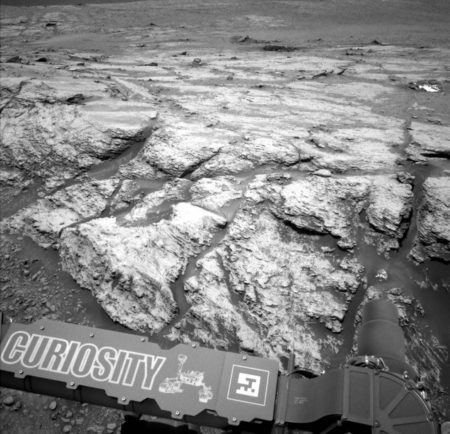August 14, 2019 – Ever since the orbiters and rovers on Mars began detecting methane in the Martian atmosphere, exobiologists have been wondering if this is a confirmation of life on the Red Planet? To rule out a non-biological origin for the source of the gas, researchers at Newcastle University decided to study wind erosion on Mars to see if this could be an explanation for periodic methane appearances. The idea was that erosion could expose rock containing chemistry of a non-biological nature that contained methane gas.
Although the Martian atmosphere is tenuous at best, the winds still blow on this planet creating much of the surface erosion observed by the robotic spacecraft, landers, and rovers we have dispatched to it. Orbiters have observed how much the landscape is shifted by winds. Jon Telling, Geochemist at the School of Natural and Environmental Sciences, Newcastle University, when describing the role of the Martian wind states that “the rate of erosion is estimated to be comparable to those of cold and arid sand dune fields on Earth.”
Ruling out wind erosion as the source for periodic methane release, therefore, made sense. The Newcastle researchers noted that detected methane on Mars is unevenly distributed and appears temporarily in isolated pockets on the surface. A biological origin based on seasonal or subsurface changes was a likely explanation. But a purely geochemical one was also plausible. No one had really considered Martian winds as the engine for methane release.
What the Newcastle researchers concluded, however, was that wind erosion could be playing a part but that the methane volumes detected suggested this was highly unlikely.
So if it is not wind erosion, what is it?
Marco Giuranna, of the National Astrophysics Institute, in Rome, participated in an international team studying Martian methane gas releases. They used data from the Curiosity rover and one of ESA’s orbiters, the Mars Express, to study a 250 square kilometer area of the Gale Crater surface. The team ran a million computer models of different emission scenarios and concluded that the most likely source for the gas was subsurface frozen methane that was occasionally leaking. But as to what created this methane layer, the team had no answer.
Near the end of June of this year, the Jet Propulsion Laboratory-Caltech team that is working with the Curiosity rover announced that they had detected the largest transient plume of methane coming from the Gale Crater so far. The amount was 21 parts per billion measured by SAM’s (sample analysis laboratory) tunable laser spectrometer.
On Earth, microbial life called methanogens, are a big source of atmospheric methane. You find methanogens in the gut bacteria of cows. You also find them in melting permafrost, in peat bogs, and almost anywhere there is decaying vegetation.
But some methane on Earth has geological origins. For example, volcanoes on Earth belch methane, although there is no evidence of active volcanism on Mars today. So we can rule out volcanism as a Martian methane source.
So what other Martian geological processes are likely the methane source?
Could the weathering of carbonate rocks exposed to liquid water in the right temperature conditions produce methane? This chemical origin of methane would follow a pattern of seasonal variation based on the rise and fall of daily temperatures. Seasonal methane variation has been observed on Mars.
But a biological origin would equally be plausible when looking at seasonal methane on Mars. Martian microbes would be more active in the right temperature conditions.
But Gale Crater methane observations have also been sudden with transient plumes of the gas being detected. It’s as if the planet is doing its own version of “cow farts.”
And even curiouser and curiouser is the lack of data showing methane’s presence from ESA’s ExoMars Trace Gas Orbiter, which has been circling the planet for the last year looking for the gas. Talk about causing methane confusion back here on Earth for exobiologists and geochemists who are still trying to figure out if Mars has native microbial life or just some exotic geological processes.















